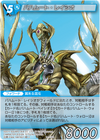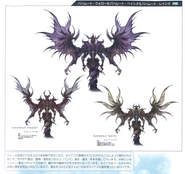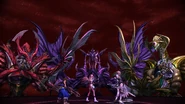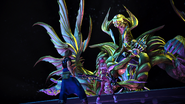Template:Sideicon Template:Enemy Amber Bahamut is one of the two enemies accompanying Jet Bahamut in the final battle in Final Fantasy XIII-2.
Stats
Template:XIII2 Enemy Stats
Battle
Of the two bodyguards of Jet Bahamut, Amber Bahamut uses magical attacks and also halves damage from them. Amber Bahamut also halves damage from the counter of the two elements Garnet Bahamut resists. Amber Bahamut only has 141,200 HP, making it relatively easy to take down.
Amber Bahamut casts powerful magic on the party, and inflicts some minor status ailments. Amber Bahamut is arguably the weaker of the two sidekicks Jet Bahamut calls forth, as its attacking power is low. Multicast and Light Eruption do low amounts of damage, but his Apparition Ray can bring a party member down to around 10% health. Like Garnet Bahamut, Amber Bahamut can be resurrected by Jet Bahamut.
Strategy
With a relatively average chain resistance, average-leveled parties will be able to switch to a paradigm] such as Relentless Assault (RAV/RAV/COM) to quickly stagger Amber Bahamut, and then switch to the Cerberus (COM/COM/COM) to make quick work of the foe.
Other appearances
Final Fantasy Trading Card Game
Template:Sideicon
Amber Bahamut appears in Final Fantasy Trading Card Game with an Ice-elemental card.
Gallery
Etymology
Amber is fossilized tree resin which has been appreciated for its color and natural beauty since Neolithic times as a gemstone. Amber is used as an ingredient in perfumes, as a healing agent in folk medicine, and as jewelry.
Bahamut (Arabic بهموت Bahamūt) originated as an enormous whale in ancient pre-Islamic Arabian mythology. Upon Bahamut's back stands a bull with four thousand eyes, ears, noses, mouths, tongues and feet called Kujuta (also spelled "Kuyutha") (compared with the pair of Behemoth and Leviathan). Between each of these is a distance of a 500-year journey. On the back of Kujuta is a mountain of ruby. Atop this mountain is an angel who carries six hells, earth, and seven heavens on its shoulders.
Another version of the Arabic story is that Bahamut is indeed a dragon and he stands on a whale called Liwash.
In modern times, the game Dungeons & Dragons is responsible for reimagining Bahamut as the king of dragons, a benevolent Platinum Dragon; the opposite of the malevolent Tiamat, the five-headed Chromatic Queen of Dragons.
The Japanese names of the three Winged Chaos Bahamuts are translated as Bahamut Volo, Bahamut Passio, and Bahamut Ratio. Volo is the Latin word for "fly" or '"will'", while Passio and Ratio are the Latin words for "passion" and "reason", respectively.
Trivia
- Amber Bahamut somewhat resembles the left half of Orphan from Final Fantasy XIII. They share similar coloring, identical arm positions, and excel in magic and healing spells.






